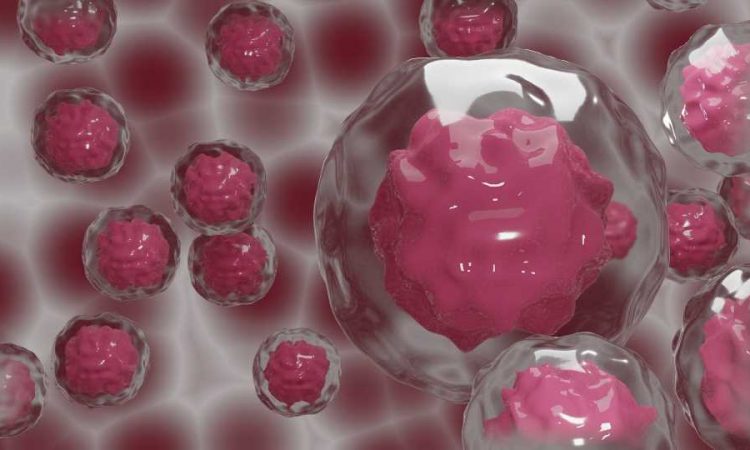
Scientists have discovered why breast cancer cells that have spread to the lungs may “wake up” following years of sleep, forming incurable secondary tumors.
Their research reveals the mechanism that triggers this breast cancer “time bomb”—and suggests a strategy to defuse it.
Patients with estrogen receptor positive (ER+) breast cancer—the most common type—have a continued risk of their cancer recurring in another part of their body for many years or even decades after their original diagnosis and treatment.
When breast cancer cells spread from the first cancer in the breast to other parts of the body it is called secondary or metastatic breast cancer and although treatable, it can’t be cured.
The new research, published today in the journal Nature Cancer, showed how molecular changes within the lung that occur during aging can support the growth of these secondary tumors.
The team at The Institute of Cancer Research, London, found that the PDGF-C protein, which is present in the lung, plays a key role in influencing whether inactive breast cancer cells stay asleep or “wake up.”
They discovered that if the level of PDGF-C increases, which is more likely in an aging lung or when its tissue becomes damaged or scarred, it can cause the dormant cancer cells to grow and develop into secondary breast cancer.
The researchers then explored whether blocking PDGF-C activity could prevent the “reawakening” of these cells and the growth of secondary tumors.
Working with mice with ER+ tumors, researchers in the Breast Cancer Now Toby Robins Research Center at The Institute of Cancer Research targeted PDGF-C signaling with an existing cancer growth blocker called imatinib, which is currently used to treat patients with chronic myeloid leukemia.
The mice were treated with the drug both before and after the tumors had developed. For both groups, the cancer growth in the lung was significantly reduced.
Up to 80% of primary breast cancers are ER+ and there are around 44,000 cases in the U.K. each year.
Dr. Frances Turrell, postdoctoral training fellow in the Division of Breast Cancer Research at The Institute of Cancer Research, London, said, “Cancer cells can survive in distant organs for decades by hiding in a dormant state. We’ve discovered how aging lung tissue can trigger these cancer cells to ‘reawaken’ and develop into tumors, and uncovered a potential strategy to ‘defuse’ these ‘time bombs.’ We now plan to better unpick how patients might benefit from the existing drug imatinib, and in the long term aim to create more specific treatments targeted at the ‘reawakening’ mechanism.”
Professor Clare Isacke, Professor of Molecular Cell Biology at The Institute of Cancer Research, London, said, “This is an exciting stride forward in our understanding of advanced breast cancer—and how and why breast cancer cells form secondary tumors in the lungs. Next we need to pin point when these age-related changes happen and how they vary between people, so that we can create treatment strategies that prevent cancer cells ‘reawakening.'”
Dr. Simon Vincent, director of research, support and influencing at Breast Cancer Now, said, “We know that for years after finishing breast cancer treatment many women fear the disease returning. With an estimated 61,000 people living with secondary breast cancer in the U.K., more research to understand and treat it is vital.
“This exciting discovery brings us a step closer to understanding how we can slow down or stop the development of ER+ secondary breast cancer in the lung. It has the potential to benefit thousands of women living with this ‘time bomb’ in the future, ensuring fewer patients receive the devastating news the disease has spread.”
Rachel Davies, 38, lives in Swansea with her husband David, 38, and son Charlie, 16. She was diagnosed with ER+ breast cancer in 2021 and underwent a mastectomy, lymph node removal, chemotherapy and radiotherapy.
Following a scan in May 2022, three months after finishing treatment, Rachel was told the cancer had spread to her sternum and later her spine. She is now receiving a targeted cancer drug called ribociclib and hormone therapy and has a scan every three months.
Rachel said, “I’ve seen some women finish treatment and ring that bell and celebrate it being over, and this always worries me as you can never be complacent that it won’t return. Finding out the cancer had spread when I thought it was all in the past was heartbreaking. That’s why it’s so important that research into secondary breast cancer happens so we can find new ways to stop women going through what I’m experiencing.
“My life is very different now as I had to leave my job in adult social services and give up the degree I was studying for. But I remain positive and I try not to let it get to me. It’s made me appreciate things more and I think it has made me a better person. Research like this gives me hope for women being treated for breast cancer in the future. I don’t want to waste my precious time being bitter or angry.”
More information:
Clare Isacke, Age-associated microenvironmental changes highlight the role of PDGF-C in ER+ breast cancer metastatic relapse, Nature Cancer (2023). DOI: 10.1038/s43018-023-00525-y. www.nature.com/articles/s43018-023-00525-y
Journal information:
Nature Cancer
Source: Read Full Article
